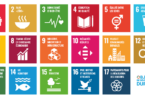L’utilisation de services infonuagiques aurait un impact positif sur l’environnement, selon un rapport publié tout récemment par la Broadband Commission for Digital Development, entité créée par les Nations Unies afin de faciliter le développement d’un accès rapide à Internet abordable dans tous les pays. Le rapport intégral peut être téléchargé en format .pdf ici. Ce rapport comporte notamment une série de recommandations visant à guider les décideurs dans l’établissement de politiques de développement durable. Certaines touchent la formation, le partage des connaissances, la recherche, ainsi que des résultats de projets de développement, au centre de nos préoccupations institutionnelles:
- Lead with vision: adopt a long-term National Broadband Plan/Strategy based on universal affordability and accessibility, open markets and innovation, and consciously connect this to your climate goals.
- Bring convergence: Bring convergence to ICT policy formulation so that it aligns with other policy areas such as energy, health, education and climate in order to maximize impact.
- Ensure regulatory certainty: Ensure clear regulatory rules and regulations on climate and broadband to create a framework of investment certainty.
- Be an example: drive cross-ministry collaboration and integrated decision-making to align climate and digital goals, and use government procurement to send the right market signals.
- Foster flexibility: identify and remove the regulatory and policy barriers currently hindering research and investment in 21st century ICT-based broadband-enabled infrastructure and low carbon solutions.
- Provide incentives: encourage uptake of low-carbon solutions and support market change by rewarding or incentivizing desired consumer behaviours. Spur innovation among individuals, companies and sectors.
- Build the market: fund and facilitate scalable pilots to demonstrate feasibility and effectiveness of broadband as an enabler of low-carbon solutions and build a strong business case to attract private investment.
- Form partnerships: cultivate connectivity and ‘co-creativity’ across public, private and non-governmental sectors and industries to help develop a collaborative mindset, shared goals and a common language, and to help break down silos.
- Measure and standardize: develop harmonized metrics and measurements and common standards for calculating both the environmental impacts of ICTs and the positive contribution technology can make to other sectors – from individual products to systems, and from individual households to the city and/or national levels.
- Share knowledge and raise awareness: actively disseminate project findings, share best practice and learn from mistakes to identify success factors and facilitate leapfrogging, especially among less developed markets. Communicate the opportunities and synergies that can be achieved through an integrated, trans-sector approach to digital development infrastructure and low carbon solutions.
Source: « New Broadband Commission climate report confirms technology is the key to a low-carbon future Governments urged to harness the power of information and communication technologies to dramatically cut emissions », Broadband Commission for Digital Development. 2 avril 2012.






